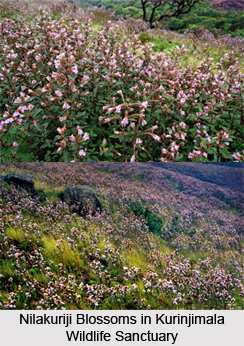 Kurinjimala Wildlife Sanctuary, situated in Idukki district of the south Indian state Kerala, is accredited as the only sanctuary of south India which conserves the endangered flowering shrub called Nilakuriji (Strobilanthus kunthianus) which blossoms only once in 12 years. Nilakuriji usually blossoms at 1300 to 2400 metres altitude. The sanctuary was established in order to ensure the preservation of the vast expanse of Kurinji habitat encompassing an area of 32 square kilometres over the shola forests of southern Western Ghats and the high elevation rolling grasslands. The place is nestled at a high altitude of Western Ghats featuring rolling hills and steep valleys. The bewitching wilderness of the forest is immensely enjoyed by wildlife photographers and nature lovers.
Kurinjimala Wildlife Sanctuary, situated in Idukki district of the south Indian state Kerala, is accredited as the only sanctuary of south India which conserves the endangered flowering shrub called Nilakuriji (Strobilanthus kunthianus) which blossoms only once in 12 years. Nilakuriji usually blossoms at 1300 to 2400 metres altitude. The sanctuary was established in order to ensure the preservation of the vast expanse of Kurinji habitat encompassing an area of 32 square kilometres over the shola forests of southern Western Ghats and the high elevation rolling grasslands. The place is nestled at a high altitude of Western Ghats featuring rolling hills and steep valleys. The bewitching wilderness of the forest is immensely enjoyed by wildlife photographers and nature lovers.
History of Kurinjimala Wildlife Sanctuary
Kurinjimala Wildlife Sanctuary was notified on 7th October 2006 by the Kerala Forest Minister Benoy Viswam during the Nilakurinji Fest organized at Munnar. In the year 2006, the wondrous and massive blooms of Nilakurinji allured around ten lakh visitors to Munnar. As per the government notification, the sanctuary is responsible for the long term protection of the unique biodiversity of the area, particularly the species of Strobilanthes kunthiana. From the sanctuary area, all the private land holdings with legal titles were excluded.
Flora and Fauna of Kurinjimala Wildlife Sanctuary
The vegetation of Kurinjimala Wildlife Sanctuary is mainly dominated by montane grasslands and sholas. The lower altitudes are however covered with deciduous and evergreen forest. The valleys are covered with grasslands interspersed with Nilakurinji and Shola forests. Common fauna found here include Sambar Deer, Nilgiri Tahr, Gaur, Tiger, Elephant and many more. Grizzled Giant Squirrel and Nilgiri Wood-Pigeon are also found here in abundance.
Visiting Information
The difficult terrain of Kurinjimala Wildlife Sanctuary makes it an enjoyable destination for adventure lovers and trekkers. Every year Nilakurinji Festival is also organized here by the Kerala forest department in the month of October. Eco tourism activities are also organized here along with local tribes in order to provide the tribal communities a means for sustainable livelihood. It also helps in promoting the tourism of the place. The place is best visited between the months of December and April. Airports at Kochi, 170 kilometres away, and Coimbatore, 160 kilometres away, are the nearest to reach the sanctuary. Aluva in Kerala, 180 kilometres away, and Udumalpett in Tamil Nadu, 110 kilometres away, serve as the nearest railway stations. Munnar is the nearest town.











